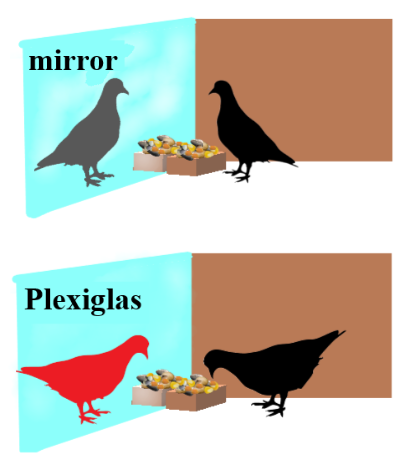2021-05-17

What do animals perceive when they are confronted with their mirror image? And how do answers to this question change our own understanding of consciousness and the relationship between humans and animals? While humans tend to intuitively project their own perception of the world onto other species, we set out to challenge the traditional binary model of mirror self-recognition, which assumes a sharp “cognitive Rubicon” that only a limited number of species seemingly can pass.
Earlier studies had shown that pigeons do not pass the traditional mark test, although they can detect synchronicity between self-and foreign movements. However, it was not clear whether they distinguish between self-movements in a mirror reflection and the movements of a real conspecific and behave accordingly. Thus, we tested pigeons in a non-traditional mirror self-recognition task in which they were forced to feed in front of their mirror reflection or in front of another conspecific. Detailed manual observations and automated analysis revealed that while the foreign pigeon was accepted as a competitor, the mirror image caused more inhibition as the reflection seemingly represented an uncanny individual. These results strengthened the case for a gradualist interpretation of MSR as opposed to the traditional binary model. By failing to succeed in spontaneous MSR tasks while being able to make a difference between their mirror image and unknown conspecific, pigeons belong to an intermediate category.

What do animals perceive when they are confronted with their mirror image? And how do answers to this question change our own understanding of consciousness and the relationship between humans and animals? While humans tend to intuitively project their own perception of the world onto other species, we set out to challenge the traditional binary model of mirror self-recognition, which assumes a sharp “cognitive Rubicon” that only a limited number of species seemingly can pass.
Earlier studies had shown that pigeons do not pass the traditional mark test, although they can detect synchronicity between self-and foreign movements. However, it was not clear whether they distinguish between self-movements in a mirror reflection and the movements of a real conspecific and behave accordingly. Thus, we tested pigeons in a non-traditional mirror self-recognition task in which they were forced to feed in front of their mirror reflection or in front of another conspecific. Detailed manual observations and automated analysis revealed that while the foreign pigeon was accepted as a competitor, the mirror image caused more inhibition as the reflection seemingly represented an uncanny individual. These results strengthened the case for a gradualist interpretation of MSR as opposed to the traditional binary model. By failing to succeed in spontaneous MSR tasks while being able to make a difference between their mirror image and unknown conspecific, pigeons belong to an intermediate category.